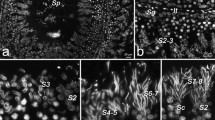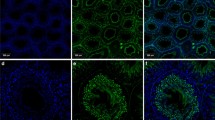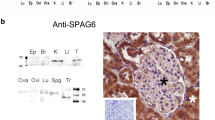Abstract
Although chemotaxis has been proposed to guide sperm to egg throughout the animal kingdom, sperm attractants released from mammalian eggs have not been identified. Since the G protein subunit α-gustducin is accepted as a marker of chemosensitive cells, attempts were made to explore whether α-gustducin is also expressed in spermatozoa of mammals. Immunohistochemical approaches using an anti-α-gustducin-specific antibody revealed the most intense immunoreactivity in differentiating spermatids. Further evidence for the α-gustducin expression was obtained analyzing testicular and sperm-derived tissue preparations in western blot analyses. To elucidate whether α-gustducin is retained in mature spermatozoa, epididymal mouse and rat sperm were subjected to immunocytochemistry as well as immunogold electron microscopy. A specific staining was obtained within the circumference of the midpiece-localized mitochondria, on the axoneme and the outer dense fibers surrounding the microtubules of this region, whereas no labeling was detectable in the end piece regions. The analysis of ejaculated bovine and human sperm revealed a comparable segmental distribution pattern for α-gustducin. Although a possible function for α-gustducin has yet to be determined, the axonemal-associated localization within the midpiece and principal piece of different mammalian spermatozoa raises the possibility that this G protein α-subunit may process intracellular signals controlling sperm motility.








Similar content being viewed by others
Abbreviations
- cAMP:
-
3′,5′-Cyclic adenosine monophosphate
- cGMP:
-
Cyclic guanosine 5′-monophosphate
- FITC:
-
Fluorescein isothiocyanate
- PDE:
-
Phosphodiesterase
- PLC:
-
Phospholipase C
- SCC:
-
Solitary chemosensory cells
References
Aigner A, Ray PE, Czubayko F, Wellstein A (2002) Immunolocalization of an FGF-binding protein reveals a widespread expression pattern during different stages of mouse embryo development. Histochem Cell Biol 117:1–11
Baxendale RW, Fraser LR (2003) Immunolocalization of multiple Galpha subunits in mammalian spermatozoa and additional evidence for Galphas. Mol Reprod Dev 65:104–113
Bohmer M, Van Q, Weyand I, Hagen V, Beyermann M, Matsumoto M, Hoshi M, Hildebrand E, Kaupp UB (2005) Ca2+ spikes in the flagellum control chemotactic behavior of sperm. Embo J 24:2741–2752
Bradford MM (1976) A rapid and sensitive method for the quantitation of microgram quantities of protein utilizing the principle of protein-dye binding. Anal Biochem 72:248–254
Breer H (2003) Sense of smell: recognition and transduction of olfactory signals. Biochem Soc Trans 31:113–116
Caicedo A, Pereira E, Margolskee RF, Roper SD (2003) Role of the G-protein subunit alpha-gustducin in taste cell responses to bitter stimuli. J Neurosci 23:9947–9952
Cooper TG (2005) Cytoplasmic droplets: the good, the bad or just confusing? Hum Reprod 20:9–11
Defer N, Marinx O, Poyard M, Lienard MO, Jegou B, Hanoune J (1998) The olfactory adenylyl cyclase type 3 is expressed in male germ cells. FEBS Lett 424:216–220
Eisenbach M (2004) Towards understanding the molecular mechanism of sperm chemotaxis. J Gen Physiol 124:105–108
Fabro G, Rovasio RA, Civalero S, Frenkel A, Caplan SR, Eisenbach M, Giojalas LC (2002) Chemotaxis of capacitated rabbit spermatozoa to follicular fluid revealed by a novel directionality-based assay. Biol Reprod 67:1565–1571
Finger TE, Bottger B, Hansen A, Anderson KT, Alimohammadi H, Silver WL (2003) Solitary chemoreceptor cells in the nasal cavity serve as sentinels of respiration. Proc Natl Acad Sci USA 100:8981–8986
Fraser LR, Adeoya-Osiguwa SA, Baxendale RW (2003) First messenger regulation of capacitation via G protein-coupled mechanisms: a tale of serendipity and discovery. Mol Hum Reprod 9:739–748
Fukuda N, Yomogida K, Okabe M, Touhara K (2004) Functional characterization of a mouse testicular olfactory receptor and its role in chemosensing and in regulation of sperm motility. J Cell Sci 117:5835–5845
Gautier-Courteille C, Salanova M, Conti M (1998) The olfactory adenylyl cyclase III is expressed in rat germ cells during spermiogenesis. Endocrinology 139:2588–2599
Goto T, Salpekar A, Monk M (2001) Expression of a testis-specific member of the olfactory receptor gene family in human primordial germ cells. Mol Hum Reprod 7:553–558
Gulbransen BD, Finger TE (2005) Solitary chemoreceptor cell proliferation in adult nasal epithelium. J Neurocytol 34:117–122
He W, Yasumatsu K, Varadarajan V, Yamada A, Lem J, Ninomiya Y, Margolskee RF, Damak S (2004) Umami taste responses are mediated by alpha-transducin and alpha-gustducin. J Neurosci 24:7674–7680
Heydecke D, Meyer D, Ackermann F, Wilhelm B, Gudermann T, Boekhoff I (2006) The multi PDZ domain protein MUPP1 as a putative scaffolding protein for organizing signaling complexes in the acrosome of mammalian spermatozoa. J Androl 27(3):390–404
Hofer D, Drenckhahn D (1998) Identification of the taste cell G-protein, alpha-gustducin, in brush cells of the rat pancreatic duct system. Histochem Cell Biol 110:303–309
Hofer D, Puschel B, Drenckhahn D (1996) Taste receptor-like cells in the rat gut identified by expression of alpha-gustducin. Proc Natl Acad Sci USA 93:6631–6634
Howes EA, Hurst SM, Jones R (2001) Actin and actin-binding proteins in bovine spermatozoa: potential role in membrane remodeling and intracellular signaling during epididymal maturation and the acrosome reaction. J Androl 22:62–72
Huang L, Shanker YG, Dubauskaite J, Zheng JZ, Yan W, Rosenzweig S, Spielman AI, Max M, Margolskee RF (1999) Ggamma13 colocalizes with gustducin in taste receptor cells and mediates IP3 responses to bitter denatonium. Nat Neurosci 2:1055–1062
Inaba K (2003) Molecular architecture of the sperm flagella: molecules for motility and signaling. Zool Sci 20:1043–1056
Kaupp UB, Solzin J, Hildebrand E, Brown JE, Helbig A, Hagen V, Beyermann M, Pampaloni F, Weyand I (2003) The signal flow and motor response controling chemotaxis of sea urchin sperm. Nat Cell Biol 5:109–117
Laemmli UK (1970) Cleavage of structural proteins during the assembly of the head of bacteriophage T4. Nature 227:680–685
Livera G, Xie F, Garcia MA, Jaiswal B, Chen J, Law E, Storm DR, Conti M (2005) Inactivation of the mouse adenylyl cyclase 3 gene disrupts male fertility and spermatozoon function. Mol Endocrinol 19:1277–1290
Margolskee RF (2002) Molecular mechanisms of bitter and sweet taste transduction. J Biol Chem 277:1–4
McLaughlin SK, McKinnon PJ, Margolskee RF (1992) Gustducin is a taste-cell-specific G protein closely related to the transducins. Nature 357:563–569
Meggiolaro D, Porcelli F, Scanziani E, Consiglio AL, Carnevali A, Ferrandi B (2003) ILA 147 immunoreactivity of the bull spermatozoa membrane during epididymal maturation. Acta Histochem 105:231–238
Merigo F, Benati D, Tizzano M, Osculati F, Sbarbati A (2005) alpha-Gustducin immunoreactivity in the airways. Cell Tissue Res 319:211–219
Milligan G, Kostenis E (2006) Heterotrimeric G-proteins: a short history. Br J Pharmacol 147(Suppl 1):S46–S55
Munuce MJ, Caille AM, Botti G, Berta CL (2004) Modulation of human sperm function by follicular fluid. Andrologia 36:395–401
Neesen J, Hartwich T, Brandhorst G, Aumuller G, Glaser B, Burfeind P, Mendoza-Lujambio I (2002) Tep22, a novel testicular expressed gene, is involved in the biogenesis of the acrosome and the midpiece of the sperm tail. Biochem Biophys Res Commun 297:737–748
Oliveira RG, Tomasi L, Rovasio RA, Giojalas LC (1999) Increased velocity and induction of chemotactic response in mouse spermatozoa by follicular and oviductal fluids. J Reprod Fertil 115:23–27
Parmentier M, Libert F, Schurmans S, Schiffmann S, Lefort A, Eggerickx D, Ledent C, Mollereau C, Gerard C, Perret J et al (1992) Expression of members of the putative olfactory receptor gene family in mammalian germ cells. Nature 355:453–455
Peterson JJ, Orisme W, Fellows J, McDowell JH, Shelamer CL, Dugger DR, Smith WC (2005) A role for cytoskeletal elements in the light-driven translocation of proteins in rod photoreceptors. Invest Ophthalmol Vis Sci 46:3988–3998
Ralt D, Manor M, Cohen-Dayag A, Tur-Kaspa I, Ben-Shlomo I, Makler A, Yuli I, Dor J, Blumberg S, Mashiach S et al (1994) Chemotaxis and chemokinesis of human spermatozoa to follicular factors. Biol Reprod 50:774–785
Rasenick MM, Donati RJ, Popova JS, Yu JZ (2004) Tubulin as a regulator of G-protein signaling. Methods Enzymol 390:389–403
Rössler P, Boekhoff I, Tareilus E, Beck S, Breer H, Freitag J (2000) G protein betagamma complexes in circumvallate taste cells involved in bitter transduction. Chem Senses 25:413–21
Rössler P, Kroner C, Freitag J, Noe J, Breer H (1998) Identification of a phospholipase C beta subtype in rat taste cells. Eur J Cell Biol 77:253–261
Ruiz-Avila L, Ming D, Margolskee RF (2000) An In vitro assay useful to determine the potency of several bitter compounds. Chem Senses 25:361–368
Sbarbati A, Crescimanno C, Bernardi P, Osculati F (1999) Alpha-gustducin-immunoreactive solitary chemosensory cells in the developing chemoreceptorial epithelium of the rat vallate papilla. Chem Senses 24:469–472
Sbarbati A, Osculati F (2003) Solitary chemosensory cells in mammals? Cells Tissues Organs 175:51–55
Scholey JM (2003) Intraflagellar transport. Annu Rev Cell Dev Biol 19:423–443
Shepherd GM (1991) Sensory transduction: entering the mainstream of membrane signaling. Cell 67:845–851
Shi YB, Liang VC (1994) Cloning and characterization of the ribosomal protein L8 gene from Xenopus laevis. Biochim Biophys Acta 1217:227–228
Spehr M, Hatt H (2005) A potential role of odorant receptor agonists and antagonists in the treatment of infertility and contraception. Curr Opin Investig Drugs 6:364–368
Spehr M, Gisselmann G, Poplawski A, Riffell JA, Wetzel CH, Zimmer RK, Hatt H (2003) Identification of a testicular odorant receptor mediating human sperm chemotaxis. Science 299:2054–2058
Spehr M, Schwane K, Riffell JA, Barbour J, Zimmer RK, Neuhaus EM, Hatt H (2004) Particulate adenylate cyclase plays a key role in human sperm olfactory receptor-mediated chemotaxis. J Biol Chem 279:40194–40203
Sun F, Bahat A, Gakamsky A, Girsh E, Katz N, Giojalas LC, Tur-Kaspa I, Eisenbach M (2005) Human sperm chemotaxis: both the oocyte and its surrounding cumulus cells secrete sperm chemoattractants. Hum Reprod 20:761–767
Takesono A, Cismowski MJ, Ribas C, Bernard M, Chung P, Hazard S III, Duzic E, Lanier SM (1999) Receptor-independent activators of heterotrimeric G-protein signaling pathways. J Biol Chem 274:33202–33205
Turner RM (2003) Tales from the tail: what do we really know about sperm motility? J Androl 24:790–803
Vanderhaeghen P, Schurmans S, Vassart G, Parmentier M (1993) Olfactory receptors are displayed on dog mature sperm cells. J Cell Biol 123:1441–1452
Vanderhaeghen P, Schurmans S, Vassart G, Parmentier M (1997) Specific repertoire of olfactory receptor genes in the male germ cells of several mammalian species. Genomics 39:239–246
von Buchholtz L, Elischer A, Tareilus E, Gouka R, Kaiser C, Breer H, Conzelmann S (2004) RGS21 is a novel regulator of G protein signalling selectively expressed in subpopulations of taste bud cells. Eur J Neurosci 19:1535–1544
Walensky LD, Roskams AJ, Lefkowitz RJ, Snyder SH, Ronnett GV (1995) Odorant receptors and desensitization proteins colocalize in mammalian sperm. Mol Med 1:130–141
Wennemuth G, Westenbroek RE, Xu T, Hille B, Babcock DF (2000) CaV2.2 and CaV2.3 (N- and R-type) Ca2+ channels in depolarization-evoked entry of Ca2+ into mouse sperm. J Biol Chem 275:21210–21217
Weyand I, Godde M, Frings S, Weiner J, Muller F, Altenhofen W, Hatt H, Kaupp UB (1994) Cloning and functional expression of a cyclic-nucleotide-gated channel from mammalian sperm. Nature 368:859–863
Wiesner B, Weiner J, Middendorff R, Hagen V, Kaupp UB, Weyand I (1998) Cyclic nucleotide-gated channels on the flagellum control Ca2+ entry into sperm. J Cell Biol 142:473–484
Wong GT, Gannon KS, Margolskee RF (1996) Transduction of bitter and sweet taste by gustducin. Nature 381:796–800
Zancanaro C, Caretta CM, Merigo F, Cavaggioni A, Osculati F (1999) alpha-gustducin expression in the vomeronasal organ of the mouse. Eur J Neurosci 11:4473–4475
Zhang Y, Hoon MA, Chandrashekar J, Mueller KL, Cook B, Wu D, Zuker CS, Ryba NJ (2003) Coding of sweet, bitter, and umami tastes: different receptor cells sharing similar signaling pathways. Cell 112:293–301
Acknowledgments
We thank Marga Losekamp for providing expert technical assistance, Tim Plant, Andreas Breit and Thomas Büch for critical reading of the manuscript, and Heinz Breer for helpful suggestions and support for some molecular and histological experiments. This work was supported in part by the P.E. Kempkes Stifung. The experiments comply with Principles of Animal Care, publication no. 85–23, revised 1985, of the National Institutes of Health and with the current laws of Germany.
Author information
Authors and Affiliations
Corresponding author
Additional information
Johanna Fehr and Dorke Meyer contributed equally to this work.
Rights and permissions
About this article
Cite this article
Fehr, J., Meyer, D., Widmayer, P. et al. Expression of the G-protein α-subunit gustducin in mammalian spermatozoa. J Comp Physiol A 193, 21–34 (2007). https://doi.org/10.1007/s00359-006-0168-8
Received:
Revised:
Accepted:
Published:
Issue Date:
DOI: https://doi.org/10.1007/s00359-006-0168-8




